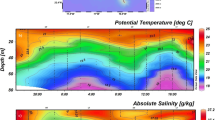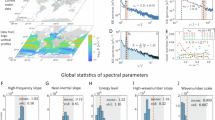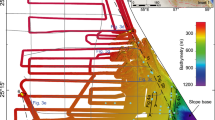Abstract
THE exchange of gases between the ocean and the atmosphere exerts an important influence on the cycling and global budget of trace gases. Air–sea gas flux is normally parameterized as the product of a gas-transfer velocity and the air–sea concentration difference1,2. Despite suggestions3–8 that the parameterization might be inappropriate when air-bubble penetration occurs, this 'thin-film' model remains widely accepted9 and is employed regularly in regional10 and global-scale11 models. Here we present a time series of ear-surface dissolved O2 from November to March in coastal waters. The time series is punctuated by sudden large increases in dissolved O2 associated with surface wave activity. A numerical simulation including air injection by bubbles shows similar behaviour. If the observed O2 'events' reflect the air–sea O2 flux, our results imply that conventional parameterizations might seriously underestimate gas invasion of surface waters under storm conditions. Our study confirms that important questions remain concerning air–sea gas transfer at high wind speeds.
This is a preview of subscription content, access via your institution
Access options
Subscribe to this journal
Receive 51 print issues and online access
$199.00 per year
only $3.90 per issue
Buy this article
- Purchase on SpringerLink
- Instant access to full article PDF
Prices may be subject to local taxes which are calculated during checkout
Similar content being viewed by others
References
Liss, P. S. & Slater, P. G. Nature 247, 181–184 (1974).
Broecker, W. S. & Peng, T.-H. Tellus 26, 21–35 (1974).
Thorpe, S. A. Phil. Trans. R. Soc. A304, 155–210 (1982).
Thorpe, S. A. Ann. Geophys. 2, 53–56 (1984).
Memery, L. & Merlivat, L. in Oceanic Whitecaps (eds Monahan, E. C. & MacNiocaill, G.) 95–100 (Reidel, Dordrecht, 1984).
Merlivat, L. & Memery, L. J. geophys. Res. 88, 707–724 (1983).
Lamarre, E. & Melville, W. K. Nature 351, 469–472 (1991).
Smith, S. D. & Jones, E. P. J. geophys. Res. 90, 869–875 (1985).
Broecker, W. S. et al. J. geophys. Res. 10517–10527 (1986).
Wallace, D. W. R. & Lazier, J. R. N. Nature 332, 61–63 (1988).
Tans, P. P., Fung, I. Y. & Takahashi, T. Science 247, 1431–1438 (1990).
Atkinson, L. P. J. geophys. Res. 78, 962–968 (1973).
Liss, P. S. & Merlivat, L. in The Role of Air-Sea Exchange in Geochemical Cycling (ed. Buat-Menard, P.) 113–127 (Reidel, Dordrecht, 1986).
Ledwell, J. J. in Gas Transfer at Water Surfaces (eds Brutsaert, W. & Jirka, G. H.) 293–302 (Reidel, Dordrecht, 1984).
Craig, H. & Weiss, R. F. Earth planet. Sci. Lett. 10, 289–296 (1971).
Craig, H. & Hayward, T. Science 235, 199–202 (1987).
Spitzer, W. S. & Jenkins, W. J. J. mar. Res. 47, 169–196 (1989).
Kanwisher, J. Deep-Sea Res. 10, 195–207 (1963).
Watson, A. J., Upstill-Goddard, R. C. & Liss, P. S. Nature 349, 145–147 (1991).
Wolfe, D. K. & Thorpe, S. A. J. mar. Res. 49, 435–466 (1991).
Garside, C. & Malone, T. C. Estuar. Coast. mar. Sci. 6, 93–104 (1978).
Author information
Authors and Affiliations
Rights and permissions
About this article
Cite this article
Wallace, D., Wirick, C. Large air–sea gas fluxes associated with breaking waves. Nature 356, 694–696 (1992). https://doi.org/10.1038/356694a0
Received:
Accepted:
Issue date:
DOI: https://doi.org/10.1038/356694a0
This article is cited by
-
Rapid transfer of oxygen to the deep ocean mediated by bubbles
Nature Geoscience (2020)
-
Analyzing wave breaking in a barred beach using wavelet
Journal of Coastal Conservation (2011)
-
Fiber-optic probe measurements of void fraction and bubble size distributions beneath breaking waves
Experiments in Fluids (2007)
-
Scale dependence of bubble creation mechanisms in breaking waves
Nature (2002)
-
Evidence for the importance of bubbles in increasing air–sea gas flux
Nature (1993)



